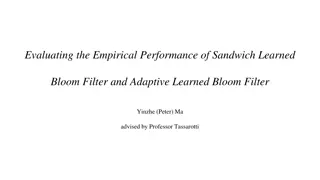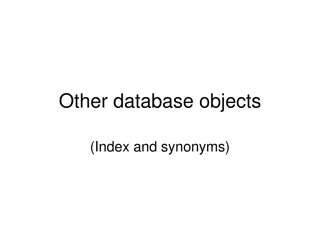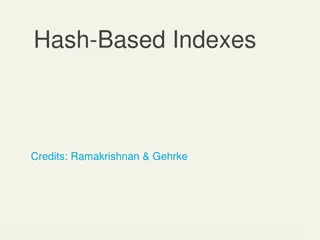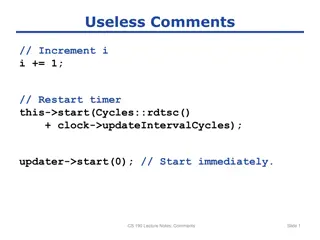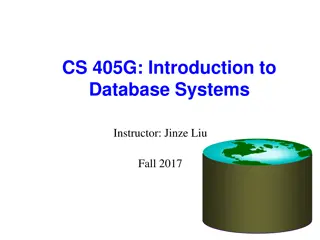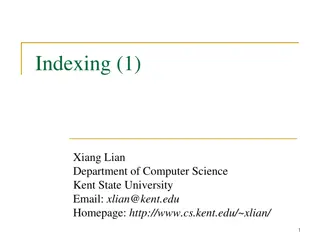Learned Indexes for Efficient Data Lookups
This content highlights the importance of efficient data lookups in systems and explores various techniques, from linear search to learned indexes. It discusses how traditional data structures and models are used to facilitate fast lookups, along with challenges and improvements in integrating learned indexes into production systems. The focus is on Bourbon, a learned index for LSM-trees, and LevelDB's structure based on LSM for key-value storage. Overall, the content provides insights into optimizing data retrieval through innovative indexing methods.
Download Presentation

Please find below an Image/Link to download the presentation.
The content on the website is provided AS IS for your information and personal use only. It may not be sold, licensed, or shared on other websites without obtaining consent from the author.If you encounter any issues during the download, it is possible that the publisher has removed the file from their server.
You are allowed to download the files provided on this website for personal or commercial use, subject to the condition that they are used lawfully. All files are the property of their respective owners.
The content on the website is provided AS IS for your information and personal use only. It may not be sold, licensed, or shared on other websites without obtaining consent from the author.
E N D
Presentation Transcript
From WiscKey to Bourbon: A Learned Index for Log-Structured Merge Trees Yifan Dai, Yien Xu, Aishwarya Ganesan, Ramnatthan Alagappan, Brian Kroth, Andrea Arpaci-Dusseau and Remzi Arpaci-Dusseau
Data Lookup Data lookup is important in systems How do we perform a lookup given an array of data? Linear search What if the array is sorted? Binary search What if the data is huge? 2 1 8 4 5 9 7 3 6 1 2 3 4 5 6 7 8 9
Data Structures to Facilitate Lookups Assume sorted data Traditional solution: build specific data structures for lookups B-Tree, for example Record the position of the data 7 8 1 2 3 What if we know the data beforehand? 3 7 1 2 3 7 8
Bring Learning to Indexing Lookups can be faster if we know the distribution The model f( ) learns the distribution Leaned Indexes Time Complexity O(1) for lookups Space Complexity O(1) Only 2 floating points slope + intercept Key x = 100 -> f(x) = 0 f(x) = 0.5x - 50 100 102 104 106 200 202 204 206 300 302 304 306 Kraska et al. The Case for Learned Index Structures. 2018
Challenges to Learned Indexes How to efficiently support insertions/updates? Data distribution changed Need re-training, or lowered model accuracy How to integrate into production systems? Key Key f(x) = 0.5x - 50 f(x) = 0.5x - 50 100 101 100 102 102 103 104 104 106 106 200 200 202 202 204 204 206 206 300 300 302 302 304 304 306 306 350 400
Bourbon Bourbon A Learned index for LSM-trees Built into production system (WiscKey) Handle writes easily LSM-tree fits learned indexes well Immutable SSTables with no in-place updates Learning guidelines How and when to learn the SSTables Cost-Benefit Analyzer Predict if a learning is beneficial during runtime Performance improvement 1.23x 1.78x for read-only and read-heavy workloads ~1.1x for write-heavy workloads
LevelDB MemTable Key-value store based on LSM 2 in-memory tables 7 levels of on-disk SSTables (files) Update/Insertion procedure Buffered in MemTables Merging compaction From upper to lower levels No in-place updates to SSTables Lookup procedure From upper to lower levels Positive/Negative internal lookups SSTable Memory L0 (8M) L1 (10M) Kmin Kmax L2 (100M) L3 (1G) L6 (1T)
Learning Guidelines Learning at SSTable granularity No need to update models Models keep a fixed accuracy Factors to consider before learning: 1. Lifetime of SSTables How long a model can be useful 2. Number of Lookups into SSTables How often a model can be useful L0 L1 L2
Learning Guidelines 1. Lifetime of SSTables How long a model can be useful Experimental results Under 15Kops/s and 50% writes Average lifetime of L0 tables: 10 seconds Average lifetime of L4 tables: 1 hour A few very short-lived tables: < 1 second L0 L1 L2 Learning guideline 1: Favor lower level tables Lower level files live longer Learning guideline 2: Wait shortly before learning Avoid learning extremely short-lived tables
Learning Guidelines 2. Number of Lookups into SSTables How often a model can be useful L0 L1 L2 Affected by various factors Depending on workload distribution, load order, etc. Higher level files may serve more internal lookups Learning guideline 3: Do not neglect higher level tables Models for them may be more often used Learning guideline 4: Be workload- and data-aware Number of internal lookups affected by various factors
Learning Algorithm: Greedy-PLR Greedy Piecewise Linear Regression From Dataset ? Multiple linear segments ? ?,? ?, ? ? ? < ????? ????? is specified beforehand In bourbon, we set ????? = 8 Train complexity: O(n) Typically ~40ms Inference complexity: O(log #seg) Typically <1 s Xie et al. Maximum error-bounded piecewise linear representation for online stream approximation. 2014
Bourbon Design Bourbon: Build upon WiscKey WiscKey: key-value separation built upon LevelDB (Key, value_addr) pair in the LSM-tree A separate value log L0 Why WiscKey? Help handle large and variable sized values Constant-sized KV pairs in the LSM-tree Prediction much easier L1 L2 Value Log
Bourbon Design IB DB DB DB DB SSTable L0 L1 L2 Model Lookup Load & Search Chunk Bourbon (model) path 2~3 s Load Find File Read Value Index Block Search Index Block Load & Search Data block WiscKey (Baseline) path ~4 s
Cost-Benefit Analyzer Goal: Minimize total CPU time A balance between always-learn and no-learn Estimated cost Table size Learn! Estimated benefit Number of lookups served Baseline path lookup time Model path lookup time
Effectiveness of Cost-Benefit Analyzer Learn most/all new tables at low write percentages Reach a better foreground latency than offline learning Limit learning at high write percentages Reduce learning time and have a good foreground latency Minimal total CPU cost in all scenarios
Evaluation Various micro and macro benchmarks Dataset Load order Request distribution Range queries YCSB SOSD On-disk database Database resides in memory Reduce data access time Better show benefits in indexing time Come back to this condition later
Can Bourbon adapt to different datasets? Micro benchmark: datasets 4 synthetic datasets: linear, normal, seg1%, and seg10% 2 real-world datasets: AmazonReviews and OpenStreetMapNY Uniform random read-only workloads Dataset Linear Seg1% Normal Seg10% AR OSM #Data 64M 64M 64M 64M 33M 22M #Seg 900 640K 705K 6.4M 129K 295K %Seg 0% 1% 1.1% 10% 0.39% 1.3% Bourbon performs better with lower number of segments Reach 1.6x gain for two real-world datasets with 1% segments
Performance with different request distributions? Micro benchmark: request distribution Read-only workloads Sequential, zipfian, hotspot, exponential, uniform, and latest Bourbon improves performance by ~1.6x Regardless of request distributions
Can Bourbon perform well on real benchmarks? Macro benchmark: YCSB 6 core workloads on YCSB default dataset Bourbon Improves reads without affecting writes Bourbon s gain holds on real benchmarks Bourbon improves reads without affecting writes
Is Bourbon beneficial when data is on storage? Performance on fast storage Data resides on an Intel Optane SSD 5 YCSB core workloads on YCSB default dataset Bourbon can still offer benefits when data is on storage Will be better with emerging storage technologies
Conclusion Bourbon Integrates learned indexes into a production LSM system Beneficial on various workloads Learning guidelines on how and when to learn Cost-Benefit Analyzer on whether a learning is worthwhile How will ML change computer system mechanisms? Not just policies Bourbon improves the lookup process with learned indexes What other mechanisms can ML replace or improve? Careful study and deep understanding are required
Thank You for Watching! The ADvanced Systems Laboratory (ADSL) https://research.cs.wisc.edu/wind/ Microsoft Gray Systems Laboratory https://azuredata.microsoft.com/

















